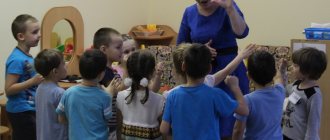Contents of the program “I – you – we”
Topics of the first section “Self-confidence”
involve providing each child with the necessary help to overcome his self-doubt and support his positive self-esteem. All this will help the child better understand other people and himself.
The formation of a child’s individuality, his “I,” begins very early and occurs gradually, including in the process of realizing his own interests and preferences. To do this, it is important for the teacher to discuss with children this or that choice of the child in different life situations and activities, and try to understand their innermost desires and dreams. It is also important to help your students get to know each other’s tastes and preferences, to see and understand that they are different. This lays the foundation for the formation of tolerance (tolerance) towards others at an older age. At the same time, children must understand that the desire to satisfy their own desires should not infringe on the interests of other people.
It is very important that a person develops a sense of self-confidence from early childhood. The teacher must help the child gradually realize that he is in many ways similar to other people, but at the same time, he is different from them in some way. You can start with the features of appearance, looking together with the child at his reflection in the mirror, gradually helping the baby to find out his preferences in eye and hair color, clothing, food, weather, season, games, activities, etc.
By organizing experiments with masks, makeup, and hats, the teacher creates conditions for children to understand that a person’s appearance can change, reflecting different moods and revealing unexpected traits of his character. Self-confidence is associated with a person’s ideas about his external and internal characteristics. Therefore, it is important for children of senior preschool age to form fairly accurate ideas about their appearance and family resemblance, along with knowledge about the endless variety of external appearances of people - children and adults.
The topics in this section have important educational significance. They not only allow you to find out how children feel about their appearance and support their positive self-esteem, but also help them develop tolerance towards other people, regardless of external qualities, physical disabilities, race and nationality. And knowing the tastes of other people will help children do something nice for them. By talking about their friends and what they like about each other, every child begins to understand how important it is to be a good friend and what it takes to do so.
The second section of the program is “Feelings, desires, views”
will help teach children to consciously perceive their emotions, feelings, experiences, as well as understand the emotional state of other people. The teacher introduces children to the language of emotions, the expressive means of which are postures, facial expressions, and gestures; teaches you to use them both to express your own feelings and experiences, and to better understand the emotional state of others. Children should gradually realize that the same objects, actions, events can cause different emotional states and cause different moods; that we recognize our internal difference from other people and our similarity with them by comparing our own and other people’s sensations and experiences.
Special topics in the section provide an opportunity to talk with children about feelings of loneliness and fear; about the need to trust in loved ones who will not give offense and will help cope with sadness and anxiety.
In older preschool age, it is expected to teach children not only to recognize various emotional moods and emotional states by external signs, but also to analyze their causes; not only understand the mood of the other, but also accept his position.
This section provides for introducing children to words denoting such emotional states as calm (peaceful, serene, benevolent, unperturbed), anger (rude, furious, angry, ferocious, spiteful, fierce), joy (festive, invigorating, bright, radiant) . Sometimes even an adult finds it difficult to express his experiences in words, since for each person they are infinitely diverse. Therefore, it is necessary to develop and enrich the appropriate vocabulary of children.
At the same time, the content of this section will help adults understand the emotional world of a child, better understand his experiences in various situations, and realize what exactly worries and pleases him. This will allow, if necessary, to provide each child who experiences emotional discomfort with special attention and help overcome negative experiences associated with life problems. In this way, the teacher can establish a more trusting relationship with children, which will facilitate the education process.
Third section “Social skills”
- involves teaching children ethically valuable forms and methods of behavior in relationships with other children. This requires the development of communication skills, the ability to establish and maintain contacts, cooperate and cooperate, and avoid conflict situations. The teacher teaches children the norms and rules of behavior, on the basis of which ethically valuable forms of communication are subsequently developed; helps to understand how easily a quarrel can arise; promotes awareness of the causes of conflicts; teaches ways and techniques for resolving them independently.
The topics in this section involve teaching children to analyze the causes of interpersonal conflicts and the ability to independently regulate them, prevent a quarrel and prevent its extreme manifestation - fighting, etc. It is also expected to teach children the norms and rules of communication and behavior. At the same time, the teacher must help children understand that doing something together is not only interesting, but also difficult, since they need to be able to negotiate, take turns, and listen to the opinions of their comrades.
The section contains topics that will help the teacher talk with children about loneliness and explain the benefits of friendship using the example of how much richer and more varied collective games are than individual ones. A number of topics introduce children to the qualities that help and hinder friendship: deceitfulness - truthfulness; attentiveness - indifference; courage - cowardice; generosity - greed.


